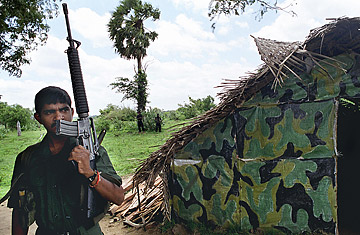
A Tamil Tiger rebel keeps watch outside a camp in a village in Sri Lanka.
The Tamil Tigers of Sri Lanka are undoubtedly one of the most organized, effective and brutal terrorist groups in the world. They invented the suicide vest and, according to the FBI, are the only terrorist group to have assassinated two world leaders. The rebels, based in northern and eastern Sri Lanka, have been waging a violent offensive against the central government on and off for more than 20 years. Federal forces recently announced they had captured the Tigers' capital, Kilinochchi, but it's a safe bet that, regardless of territory lost or possibly dwindling ranks, the guerillas will not give up their fight willingly.
The Tigers — which include 5,000 to 10,000 guerillas — are fighting to secede from the the island country of Sri Lanka. Tamils originally immigrated to Sri Lanka from southern India and make up 10 to 15% of the population, compared to the majority Sinhalese, who constitute about 75%. In 1972, the Sinhalese-controlled Sri Lankan government declared Sinhala and Buddhism the official language and religion. The Tamils, who practice Hinduism and have their own language, took this action as an affront, and Vellupillai Prabhakaran founded the Tigers soon after. The group is formally known as the Liberation Tigers of Tamil Eelam (LTTE). (See pictures of Sri Lanka on the brink of civil war in 2006)
During the first years of their existence, the Tigers were one of several resistance groups competing for support from the Sri Lankan Tamil population. But after a 1983 LTTE attack on Sri Lankan security forces sparked riots across the country that left hundreds of Tamils dead, they emerged as the dominate Tamil insurgent group. Since then, the Tigers have plotted many brutal attacks, including more than 200 by suicide bombers, according to the Council on Foreign Relations. Tens of thousands of Sri Lankans have been killed in the conflict and more have been displaced. The LTTE has bombed public buildings and transportation hubs, Buddhist temples and other locations, and is known for missions involving female suicide bombers and for recruitment of child soldiers. Fighters reportedly wear cyanide capsules around their necks that they swallow if they are about to be captured by government forces. The Tamils have ground and sea forces and are well armed with rockets, grenade launchers and other weapons.
The Indian government, which reportedly provided some quiet support to the LTTE in its early years, sent peacekeeping troops to Sri Lanka in the late 1980s to help quell the violence ravaging the country. Unable to stop the bloodshed, they pulled out by 1990. Throughout the following decade, the Tigers continued to mount violent attacks, assassinating the president in 1993 and the former Prime Minister of India in 1991, among others.
Through their history, the Tigers have financed their operations with bank robberies and drug smuggling, among other illegal acts. They are also believed to get much of their support from ethnic Tamils living in Western Europe and Canada. Some estimates say the LTTE raises more than $200 million a year.
The most recent cease-fire agreement between the Tamil Tigers and the Sri Lankan government, brokered by Norway in 2002, was constantly broken and the government officially pulled out of it in January 2008. In the past year, the federal forces have tried to forcefully put down the Tigers, pushing into their strongholds and leading up to the January 2 capture of Kilinochchi. In a speech announcing the takeover, Sri Lankan President Mahinda Rajapaksa called on the Tamil Tigers to surrender. Hours later, a suicide bomber struck the air force headquarters in the country's capital, Colombo, killing at least two.
